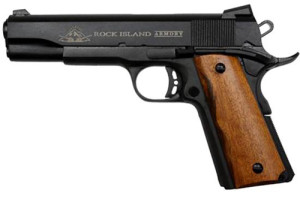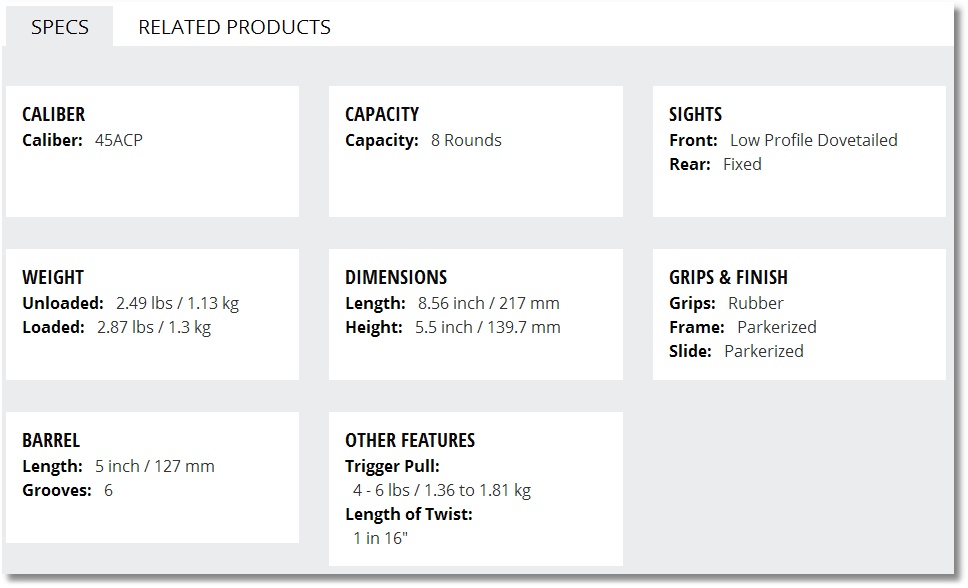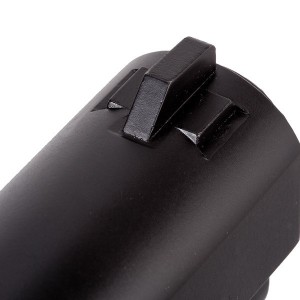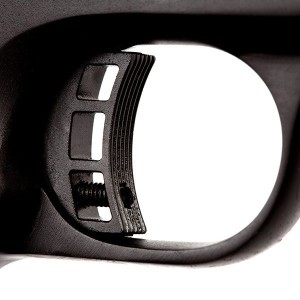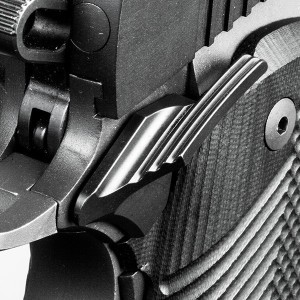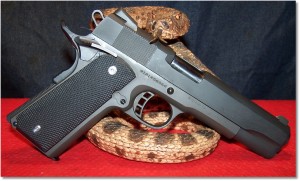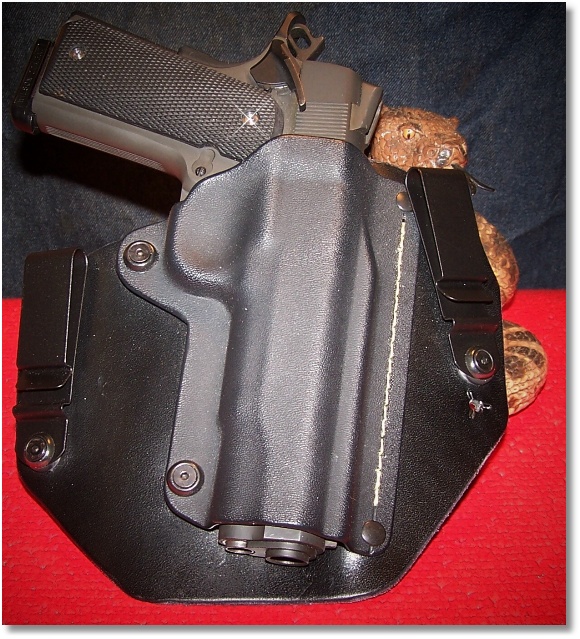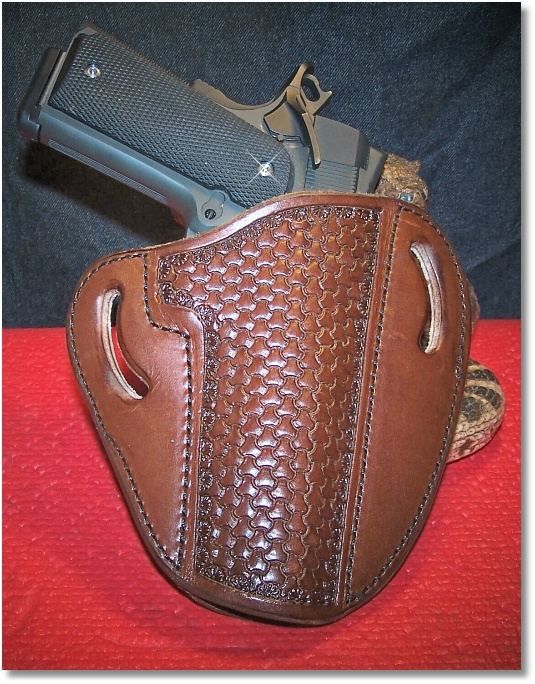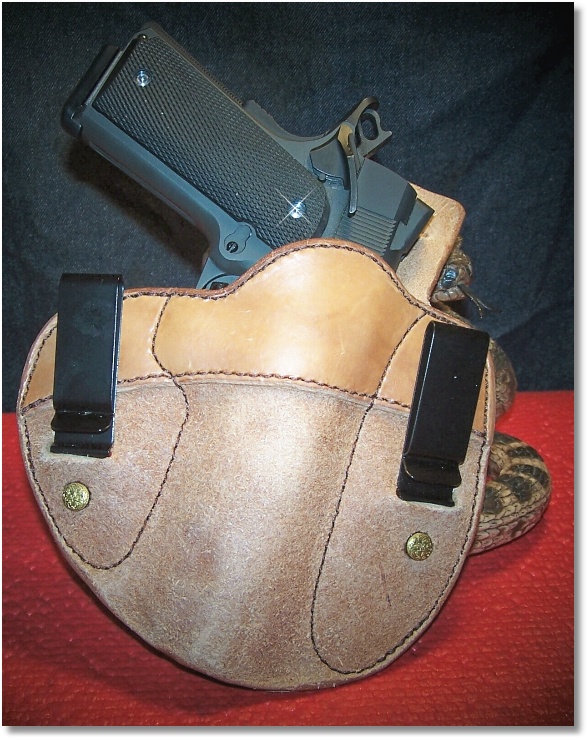I have owned the Rock Island Armory (Armscor) 1911 FS Tactical for quite some time now and I had never carried it as my EDC until recently. The pistol had a few minor issues that I had to straighten out before I considered it as a viable firearm to carry. Until now, I had no reason to write a review on it, but now I do, and here it is.
You may notice in the title that I referred to this pistol as a “2nd Generation” RIA product. This reference is somewhat of a misnomer, as this is my designation and not that of Armscor (Rock Island Armory) to distinguish between variations. The 1st Generation of 1911-based pistols had a roll-mark on the left side of the frame that contained the Rock Island logo and ROCK ISLAND ARMORY. It was a simple affair and roll-marking is not an uncommon practice. Perhaps, someone ask someone what pistol they were shooting (or carrying) and they did not know unless they looked at the pistol’s slide. What I call the 2nd Generation of Rock Island Armory pistols is because Rock Island Armory not only decided to leave the roll-marking as large as it was but also added a silver color to it. In short, the pistol became a billboard and “ROCK ISLAND ARMORY” was readily identifiable. The newer pistols do not include the large roll-marking and color fill on the slide. Rock Island Armory now has placed their logo on the rear of the slide just above the thumb safety lever. I find it very unpretentious and somewhat pleasing to the eye. Perhaps, somebody complained about the billboard and Rock Island Armory listened. I consider the newer pistols with the RIA logo on the rear of the slide just above the thumb safety lever as 3rd Generation.
The Rock Island Armory (Armscor) 1911 FS Tactical pistol that I own is a 2nd Generation pistol, which means that if I tend to forget what I am carrying I can simply look at the slide. Essentially; however, there is little no other differences between generations of each category of 1911-based pistols; FS (Full Size or “Government” model), MS (Medium Size) or “Commander” model, and CS (Compact Size or “Officer” model). Those familiar with 1911 history will be familiar with these terms – all others need to do some homework.
The Rock Island Armory (Armscor) 1911 FS Tactical is a full size, full weight, piece of hand-held fighting pistol and is chambered in.45ACP as John Moses Browning intended a 1911 to be. However, the Rock Island Armory (Armscor) 1911 FS Tactical does have a few features that makes it “Tactical” that seems to be the order of the day these days.
So, let’s get to the review.
Here are the specifications for the Rock Island Armory (Armscor) 1911 FS Tactical:
Note that with the exception of the grip type, the specifications are essentially the same as my pistol (the specs are for the 3rd Generation)
So, let me present the Rock Island Armory (Armscor) 1911 FS Tactical to you.
First of all, the pistol is chambered for the .45ACP cartridge. This is readily apparent looking into the very large hole at the end of the muzzle. While you are doing that (with an unloaded firearm), you just might take notice that there is a barrel bushing. The Rock Island Armory (Armscor) 1911 FS Tactical also has a one-piece guide rod, which has its proponents and opponents of this feature. Personally, I can live with it and I can live without it.
The front sight is the usual blade type that is dovetailed into the slide and blends in well with the pistol while providing a no-snag surface to holsters and clothing. While the front sight contains no dot, it is more than adequate for defensive use and that is what this pistol is intended for.
The frame and slide is Parkerized, which is no different from many carbon-steeled pistols on the market today. The pistol’s slide, although the same as on previous models, does have the “Rock Island Armory” billboard on the left side of the slide.
The slide incorporates a now standard relieved and lowered ejection port, which aids in ridding the pistol of expended shell casings. Early in the history of the 1911-based pistol this was a “custom” feature; today, it is commonplace as a “standard” feature.
The rear sight is a “Novak-Style” unit, is dovetailed into the frame, secured by a “hex” head screw (loosen the screw and drift the sight for windage), and is not adorned with dots or other type of sighting indicator. The width of the notch is enough to provide spacing to adequately view the front sight blade with just a hair of space on each side of the front sight. From what I understand, there are now sights available that will fit the Rock Island Armory 1911-based pistols, which was not true in the early times of these pistols. However, I have no problems with the sights and, if need be, I can paint the front sight to make it more visible.
The left side of the pistol sports the usual 1911 fare; take-down/slide lock lever, magazine release button (not extended), and an extended thumb safety lever. The take-down/slide lock lever, magazine release button, and an extended thumb safety lever all have been Parkerized and blend well with the rest of the pistol.
The magazine well is slightly beveled, which aids in locating the well and inserting a magazine. The Rock Island Armory (Armscor) 1911 FS Tactical comes with an 8-round flush fit magazine of unknown origin, although I believe it to be an ACT or Meg-Gar. The pistol; however, runs well with virtually any 1911 single-stack magazine. The Wilson Combat magazines work well as do those from Meg-Gar.
The front strap of the pistol has vertical serrations to aid in gripping the pistol (some higher-priced 1911-based pistol do not even have this). The trigger guard is nicely rounded and large enough to accommodate a gloved finger. The mainspring housing is a checkered polymer affair that now seems standard on even the most expensive COTS (Commercial-Off-The- Shelf) 1911-based pistols.
Adding to the features of the pistol is the nicely up-swept beaver-tail grip safety with memory bump, which helps to keep the shooting hand as high as possible without experiencing slide or hammer tattoos to be imprinted into your hand. The “combat” skeletonized and roiled hammer provides for easy cocking and de-cocking when necessary (or desired). The hammer also received the Parkerizing treatment and blends nicely with the rest of the pistol.
The hammer has a “half-cock notch” that operates virtually the same as every 1911-based pistol that I know of. When de-cocking the hammer, the thumb and forefinger of one hand holds the hammer and controls the hammer fall while the trigger is pulled. If the trigger is pulled and then released, the hammer can be lowered to the “half-cock notch” that keeps the hammer from contacting the firing pin. This is, and is not, considered a safety. If the trigger is pulled and held back while the hammer is being lowered, the hammer will come to rest against the firing pin. The half-cock notch is closer to the hammer’s full decocked (at rest) position. This way, even if you pulled the trigger while the hammer was half-cocked, the hammer’s fall couldn’t impact the firing pin with enough force to set off the primer in the chambered shell (it couldn’t “go off half-cocked”). In order to place the hammer in the full rest position if the hammer is resting in the “half-cock notch”, the hammer must be first moved rearward before the “half-cock notch” is engaged and supported while the trigger is pulled and held fully to the rear. If the hammer should slip while pulling the trigger fully rearward, the hammer would strike the firing pin and, if a round is chambered, it would be fired. One should always exercise care when decocking the pistol with a live round chambered (Condition 2).
Grip panels are smooth wood of some origin unknown to me. They actually feel good in the hand (at least they do in my hand). However, they were later swapped out with a grip panel that provides more of a hold on the handle, which is something that you need when the hands are sweaty and/or cold. Stainless steel, Hex-head grip panel screws (an upgrade on my part) hold the grip panels securely in place.
The trigger is a long, skeletonized type and incorporates an over-travel adjustment screw. The trigger face is serrated and flat that, I understand, is an excellent design. Since I use the first joint when shooting, the squared edge of the trigger tells me when the trigger is in the “sweet spot” on my finger. The trigger has also received Parkerizing. In fact, the only thing shiny on this pistol is the chamber of the barrel when the pistol is in battery. Trigger pull weight on this particular pistol is four and three-quarter pounds out of the box. It exhibits very little take-up before you hit the familiar “wall”, after which a crisp release of the sear is felt as the trigger is pulled rearward. Over-travel is virtually non-existent and trigger rest is very short.
The right side of the frame incorporates the feature that has my interest – a thumb safety lever. Ayup! The Rock Island Armory (Armscor) 1911 FS Tactical comes equipped with an extended ambidextrous safety. I used to scoff at ambidextrous thumb safeties on a 1911-based pistol, but that has changed, and of course, I am going to tell you why.
After I had participated in the Bare Bones Gunfighting course, which was taught by the more-than-capable CR Williams, I began to develop some of my own drills. One, in particular, involves transitioning the pistol from the right hand (my strong side) to my weak hand (and vice-versa). The drill also includes a reload (weak and strong hand). Now, releasing the magazine release is not a problem when using the trigger finger of the left (weak side) hand nor is releasing the slide lock with the same finger. Operating the safety lever; however, requires a different (and alien) set of pistol-handling skills.
I talked to one of the folks at the LGS, who is left-handed, and he told me that he shoots his 1911 left-handed with his left thumb on top of the thumb safety – on the left side. Obviously, this impacts the grip on the pistol. His right hand (weak side support) provides most of the support. I tried this and I cannot do it. Now, I have two methods that I use to run the safety and slide lock lever on the 1911 using the right hand when shooting the pistol left-handed. As the left trigger finger presses the magazine release button, the right hand loads the fresh magazine. Once the magazine is shoved into place, the right hand is used to release the slide in a “slingshot” method. Since the right hand is already in position at the rear of the slide, the right hand either comes over the rear of the pistol, or beneath the left (shooting) hand, to operate the thumb safety (if the safety is off). In most cases, I can push the safety lever on with the trigger finger of the shooting (left) hand. It is pushing the safety off safe that is the challenge. Having an ambidextrous thumb safety lever eliminates the need for right hand (weak hand) intervention when operating the 1911 left-handed. A simple press of the lever with the left thumb on the right side of the frame does the dirty deed of making the pistol “ready to rock.” The safety can also be placed in the safe position by a simple upward motion of the shooting hand thumb, while maintaining a good grip on the pistol when the fight is over, but yet remain ready to “flick the switch” if the fight is to continue.
The thumb safety has a good feel when moving from safe to fire positions with enough of a detent to makes it secure in either position. The plunger spring housing, like most 1911-based pistols, is staked to the frame and the internal spring is healthy enough to hold the slide lock and thumb safety lever but not stiff enough or interfere with proper operation. (With my Springfield 1911 Loaded, for example, a small screwdriver is necessary to press the slide lock plunger inward to install the slide lock/take-down pin assembly.)
All external controls also receive the Parkerizing treatment and they blend well with the slide and frame Parkerized finish.
As a final note, I could not find any trace of tool marks on the external surfaces of the slide or frame.
That takes care of the “pretty” stuff.
Disassembly:
While some complain about one-piece guide rods, disassembling the Rock Island Armory (Armscor) 1911 FS Tactical can be done without tools (unless you really want to use a bushing wrench, but that is up to you).
Caution! The guide rod bushing is under extreme spring pressure and is a potentially dangerous amount of energy stored in the compressed guide rod spring. Always wear safety glasses and keep the guide rod pointed away from you, any bystanders, and especially curious cats and dogs. I normally do this operation by feel and with a shop rag covering the entire muzzle of the pistol.
After the pistol is made safe, cock the hammer and push the thumb safety up to the safe position. This prevents the slide from moving rearward as you apply pressure to the guide rod bushing.
- While holding the pistol vertical, press downward on the guide rod bushing just enough to clear the barrel bushing. Maintain pressure on the guide rod bushing while twisting the barrel bushing clockwise.
- Once the barrel bushing clears the guide rod bushing, slowly release the guide rod bushing from the slide (the left hand can help prevent the guide rod bushing from flying skyward by holding the guide rod spring as the guide rod bushing is removed.
- When all spring tension is removed, remove the guide rod bushing from the spring and set it aside.
- Move the slide rearward until the take-down notch aligns with the take-down pin/slide-lock lever.
- Push the take-down pin/slide-lock lever assembly out of the pistol and set it aside.
- Remove the slide from the frame.
- Remove the recoil spring from the recoil guide rod.
- Remove the recoil guide rod from the rear of the slide.
- From the front of the slide, twist the barrel bushing counter-clockwise and remove the barrel bushing from the slide.
- Remove the barrel from the slide through the front opening.
Disassembly is now complete.
I have talked about the pretty exterior stuff so let’s move to the interior stuff that, while not pretty, is essential to the pistol’s operation.
CLEANING, INSPECTION, AND LUBRICATING:
I normally clean parts like the barrel, guide rod, and guide rod spring with Brake-Kleen to start, which removes all lubricants from these assemblies. The barrel is further cleaned with Hoppes, nylon bore brush, and bore jags with appropriately-sized patches. Everything else (except the grip panels) gets a wipe-down with appropriate cleaning chemicals, soft brushes, and then wiped down with a light coat of Ballistol.
The slide incorporates an internal extractor and the frame-mounted ejector is substantial. The breech face showed signs of firing (a test round) and that was cleaned with an appropriate brush to remove any leftover debris from the test firing. Everything looked great!
The Rock Island Armory (Armscor) 1911 FS Tactical pistol is built in traditional classic 70 series design and is delivered with Rock Island’s top quality production and engineering standards. This pistol has a 5.0” button rifled barrel supported by a full length guide rod. The barrel, as was mentioned earlier, is a standard barrel and incorporates the John Moses Browning designed swinging link.
The slide rails are inspected to detect possible wear points. The slide contact points are coated with a light coating of Lubriplate NO. 130-A. The barrel locking lugs, internal to the slide and external to the barrel are also Lubriplate NO. 130-A treated. Lubriplate NO. 130-A is also used on the guide rod and the outside of the barrel itself.
While the above seems like overkill, I know people that run a new 1911-based pistol dry. When I asked why, the response that I received is that running a slide dry will allow to metal-to-metal contact to “bed” them in – whatever that means. To me that philosophy is akin to buying a car and then running the engine without oil so that the rings will “bed” with the cylinders.
The inside of the slide is well machined and finished, which is surprising as one would expect an inexpensive pistol to be roughly machined and finished. The internal extractor blends perfectly with the rear of the slide and there are no “look see” or other indicators that the chamber is loaded. The frame is as well machined and finished internally and I could not find any machining marks. The manufacturer states; “All Rock Island 1911’s, each is built using 4140 ordinance steel on the industries best CNC machines while being hand fitted and tested to strict tolerance guidelines for unmatched quality and value.” From what I see, I believe it.
Everything checked out. Now comes the fun of assembling the Rock Island Armory (Armscor) 1911 Standard MS. This is one time that I do use a barrel bushing wrench.
ASSEMBLY:
Assembling the pistol is pretty straightforward and I am not going to go into detail here. Although the Rock Island Armory (Armscor) 1911 FS Tactical pistol incorporates a full length guide rod, the installation of the recoil spring bushing is the same as with a standard 1911.
I lock the slide into place with the thumb safety to prevent it from sliding rearward. While my left hand is supporting the front of the pistol and also provided some support for the recoil spring, I simply press the recoil spring inward toward the pistol with my thumb while keeping the stuff that could fly up and out away from the face. Once the recoil spring bushing just clears the barrel bushing, I use my left hand to move the barrel bushing over just enough to catch the edge of the guide rod bushing. Once I am assured that nothing is going to fly upward and take out the ceiling and the hardwood floor above my office, I grab my trusty bushing wrench and finish installing the guide rod bushing.
Now that assembly is over, I place the safety in the “run” position and perform a function check.
The fit of the slide-to-frame is tight. This is not your Grand Daddy’s 1911. While the Rock Island Armory (Armscor) 1911 FS Tactical pistol may resemble an updated old warhorse, it is a far superior firearm to those of yore and can provide “warm fuzzies” as only a good 1911-based pistol can.
With all that out of the way, one obvious question should come to mind; “How does it shoot?”
RANGE TIME:
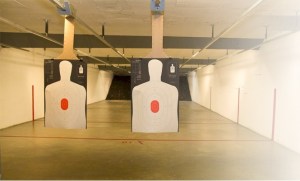 When I first took the Rock Island Armory (Armscor) 1911 FS Tactical pistol to the range, several issues arose. First, the recoil spring was too weak; the pistol would not chamber a round fully regardless of the method used. Fortunately, I keep several recoil springs for various lengths of 1911s in the “.45 Possible Bag.” I installed a #18 Wilson Combat recoil spring for a full-size 1911. (Note that I have not had an issue like this with any other RIA product. The originally-installed spring was just too light.) After installing the new recoil spring that, incidentally, took a lot more exertions to install than did the recoil spring that came with the pistol, the Rock Island Armory (Armscor) 1911 FS Tactical pistol would chamber a doorknob if it was sized to the chamber.
When I first took the Rock Island Armory (Armscor) 1911 FS Tactical pistol to the range, several issues arose. First, the recoil spring was too weak; the pistol would not chamber a round fully regardless of the method used. Fortunately, I keep several recoil springs for various lengths of 1911s in the “.45 Possible Bag.” I installed a #18 Wilson Combat recoil spring for a full-size 1911. (Note that I have not had an issue like this with any other RIA product. The originally-installed spring was just too light.) After installing the new recoil spring that, incidentally, took a lot more exertions to install than did the recoil spring that came with the pistol, the Rock Island Armory (Armscor) 1911 FS Tactical pistol would chamber a doorknob if it was sized to the chamber.
With the chambering issue fixed, the next step was to check accuracy. Unfortunately, the POI was well lower than POA with 230-grain FMJ. The front sight has a front slope to it and I guestimated how much I needed to take off the top of the front sight in order to bring the POI up. The range day pretty much ended after this.
A week passed and I was able to file the front sight down to the exact dimension that I needed according to the most advanced calculations known to man, which means that I eye-balled it. Essentially, the front rearward slope of the front sight was removed so that the top of the front sight was parallel with the slide. After that was done, the face of the front sight was painted with a white base-coat and then fluorescent red to make the front side stand out a little better than stock. Additionally, the top of the front sight, which had to be filed down, had to be painted and a coat of flat black took care of that. The next trip to the range told the tale. Aiming just a “shy high” of the bull was resulting in a series of holes appearing within the bulls-eye. In other words, cover what you want to hit with the barrel, pull the trigger, the skies part, thunder rolls, and .45 caliber holes appear pretty near where you want them to – if I did my part.
At that point, the Rock Island Armory (Armscor) 1911 FS Tactical pistol was deemed glorious and relegated to the safe, as I was carrying another pistol at the time (Bersa .45 ACP Thunder Pro). But now, since the Rock Island Armory (Armscor) 1911 FS Tactical pistol is my EDC (until the next pistol comes along), a few changes had to be made to the pistol, but not really that many.

RIA 1911 FS Tactical (2nd Generation) with Updated Grip Panels and COntrasting Stainless Steel Grip Screws
The front sight had already been painted, but the stock grip panels of smooth wood had to go. A set of Uncle Mike’s rubber checkered grip panels were installed after some minor “fitting” to clear the safety levers on both sides. These grip panels, coupled with the serrated front strap and nicely checkered main spring housing, really made a difference in gripping the pistol. To add somewhat of an accent to the pistol, I opted for a set of stainless steel, short, hex-head grip screws. While not enhancing the accuracy of the pistol, they do accent the silver, roll-marked billboard on the slide.
I may add better sights to the pistol and Armscor publishes much needed sight dimensions on their website. I do not care for fiber front sights, as is included with many fine pistols of the day. However, I have no problem with the existing sight and find it useful enough for defensive use.
The Rock Island Armory (Armscor) 1911 FS Tactical pistol has performed as well as any 1911-based pistol that I own, have owned, or have shot in the past.
SUMMARY:
I initially chose the Rock Island Armory (Armscor) 1911 FS Tactical pistol because of my experience with the RIA 1911 FS “Government” model and wanted another 1911-based pistol with a few more bells and whistles without breaking the bank. I welcome the beaver-tail grip safety, the NOVAK style sights, and especially now, the ambidextrous thumb safety. The extremely nice skeletonized trigger with over-travel adjustment is a nice touch after using the short trigger of the standard “Government” model that, by the way, has an excellent trigger. The one-piece, full-length guide rod garners much discussion, but the way I feel about it, if it works – let it be. If nothing else, it add about one-ounce of weight at the barrel end anything that can help with recoil management I am all for.
In comparing the performance of the Rock Island Armory (Armscor) 1911 FS Tactical with other 1911-based pistols, I have found no flaws. Accuracy, operability, and reliability is on par with any COTS 1911-based pistol in its class. The RIA shoots as well as the Springfield Loaded, the Ruger SR1911, and the Para Ordinance Expert – all at a less cost than the others. While the lack of 3-dot sights may be an issue to some, the sights can be changed later on to something better if you so desire.
The Rock Island Armory (Armscor) 1911 FS Tactical is not your Grand Daddy’s 1911. While the overall heftiness belies its origin as an all-steel fighting pistol that developed ion 1909 and was in use from 1911 until 1986 by the U.S. military (and other organizations such as the Mafia and FBI, to name a couple), modern materials and manufacturing processes are churning out 1911-based pistols with a degree of quality and features unheard of in reasonably-priced pistols.
While I will grant you that the Rock Island Armory (Armscor) 1911 FS Tactical is no lightweight at 2.87 pounds loaded, and just that may turn some away from even considering it, remember that the forerunner of this pistol had seen the halls of Montezuma to the shores of Tripoli and everything in between. Many men, like my Father, brought the 1911 back home with them after the wars were over. Really, how can you expect more from a fighting pistol than being able to go home after the battle? Stick an 8-round magazine in this thing and you have a truly, lean, mean, fighting machine to work with. With that said, I have to admit that carrying the Ruger SR1911CMD-A is pleasant carry, but I don’t feel that I have as much continuity with my “inner warrior” when carrying it. Sorry, I was waxing philosophical.
I will also grant you that it takes a bit to conceal this bad boy, being a full size fighting pistol and all. With proper attire, a good gun belt, and a good IWB or OWB holster, I can conceal this pistol as well as I can a Springfield XDs.
The bottom line is that if you are looking for a quality 1911, in one or all of the three different flavors (small, medium, and family-economy size), I have no qualms in steering you to what is perhaps one of the most under-rated brand of 1911s available, the Rock Island Armory (Armscor) pistols. In fact, I have a new Rock Island Armory (Armscor) 1911 Standard MS pistol in .45 ACP (51443) on order, as I really like the “Commander” length barrel for concealed EDC. I’ll be writing a review on this one in the near future.
RESOURCES:
Armscor/Rock Island Armory: http://armscor.com/
Armscor/Rock Island Armory 1911 Product recoil Spring guide:
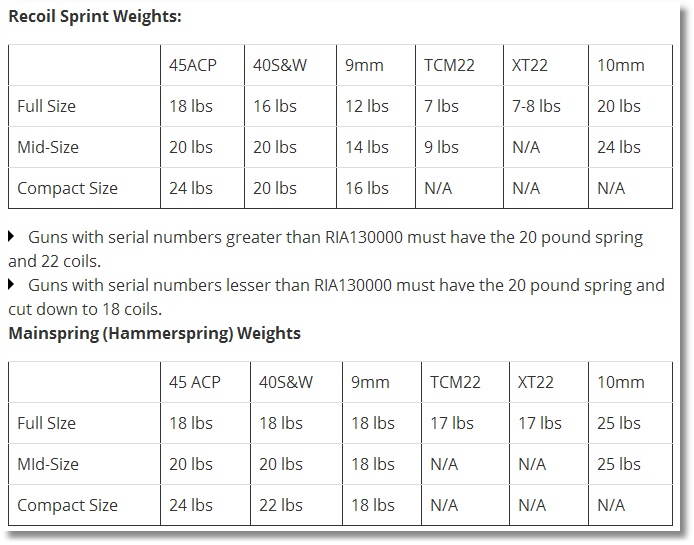
![]()


